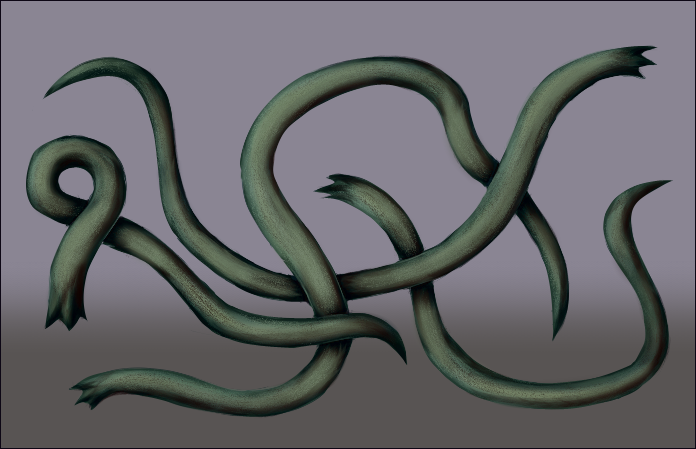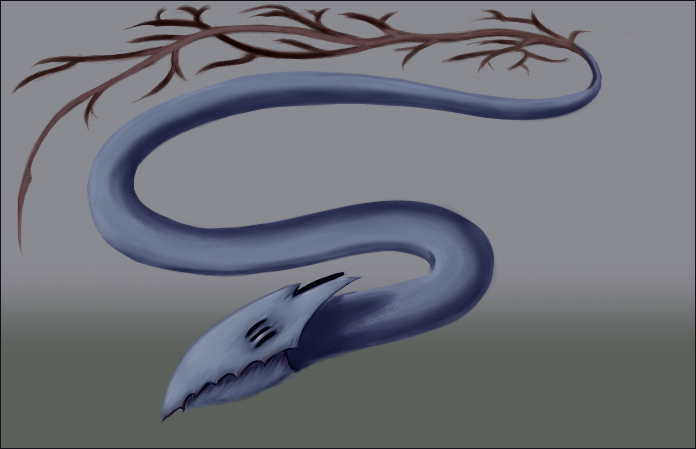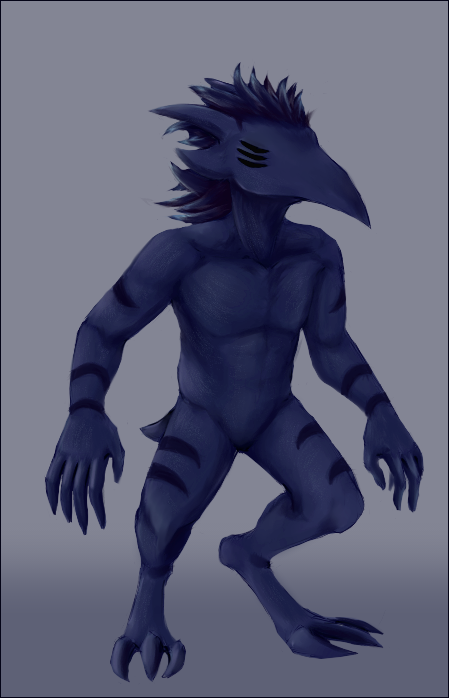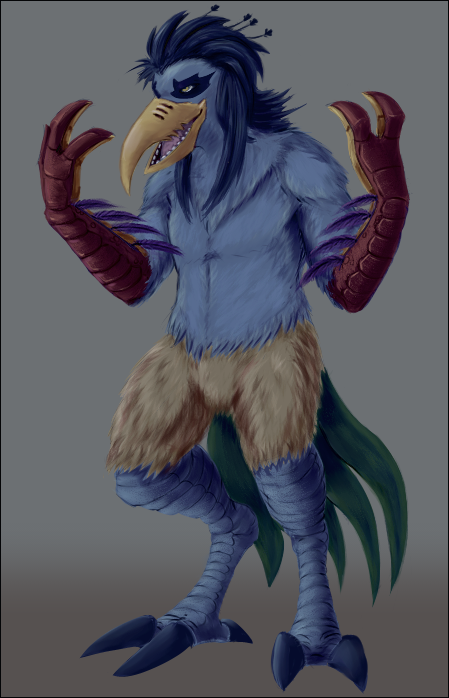Parasites
Chirua has a problem with various parasites, whose destructive behaviors create major difficulties in the lives of both Etai-irin and Ichauri-irin. A peculiar detail about them is that these creatures do not seem to have evolved from others, so far being the only species within their entire evolutionary lineages. Some of them also have biological functions that are difficult to understand. This has encouraged speculation that they are not native to Zeirenjier, and had recently appeared through unknown means.
This article will be discussing the most destructive types: insarin, silver-metal worms, blackrivers, and hawkvandals. While Indanach does what it can to reduce their populations, the parasites continue to plague Ravenguard.
Insarin

Insarin (Insarin Cirin) are a species of green worms that are almost never solitary, often paired with at least one other. The reason for insarin notoriety is their instinctive behavior of crawling into the eye sockets of larger creatures and eating away at their optic nerves. As they do so, they fuse to the eye and the brain, effectively replacing what they have destroyed.
Creatures subjected to insarin are not permanently blinded. They retain the ability to see, and any pre-existing impairment in their vision is "cured." Movements of the eyes and plain daily life causes no pain. Furthermore, the vision of the afflicted does not degrade over time, as all parts of the eye are repaired and more efficiently maintained. Had this been the only effects insarin infection had, it may not have been classified as a harmful parasite.
When a creature has their vision restored after the initial infection, nothing is out of the ordinary. One may think becoming afflicted was a good thing, should their vision improve afterward. Following an indeterminable amount of time, the afflicted start to see things that they hadn't prior. Obscurities start appearing in their peripheral vision, though only lasting for a fraction of a second. As life continues, the oddities appear more often and clearer, impossible to miss as they linger at the center of the victim's vision.
What these oddities look like have been different per account, the shapes varying from animals, to objects, to Ichauri-irin, and non-existent creatures. Insarin victims say that these hallucinations don't stop at vision, claiming that they hear the entities make noise or speak to them. They behave as if they were true living beings in the same space, but any attempt the afflicted takes to make physical contact with them inevitably fails.
The hallucinations eventually become so common that the afflicted experiences them at all times without rest. Portions of their reality become obscured by incorporeal entities, their hearing disturbed by sounds of unknown origin or talkative life forms. Sufferers can only ease their troubles by keeping their eyes closed—being unable to see the visual hallucinations also ceases the auditory ones. Some have resorted to permanently damaging their own eyes to stop them completely, after enduring the effects of insarin for so long.
Half-Affliction
Despite many cases ending in total vision loss, deliberate infection of insarin is a last-resort treatment available for those who wish to repair their failing vision, regardless of the cost. Insarin have also been discovered to allow the afflicted to see through Saulzienne's Invisible Will and nullify that variant of the ability entirely, opening up the possibility of using insarin for security detail in the most important of restricted areas.
Silver-metal Worms

Silver-metal Worms (Deamagani Cirin) are the parasitic worms that greatly resemble white-metal worms, but do not share any similar genetics. They target sentient creatures larger than themselves and burrow under their skin when given the opportunity, often when the creatures are asleep. A worm will continue to bore through tissues until it reaches the creature's upper back, at which it settles and fuses to what is now its permanent host. This is what creates a vampire.
Outside a host, silver-metal worms are fragile and non-threatening; they have no strength or poison to defend themselves with, and cannot burrow into another creature fast enough to avoid being caught. They will feed on decaying organic matter in this state, but also look for a vulnerable creature that will help it acquire the substance it desires the most.
Silver-metal worms will reproduce in two different ways. As an independent being, it will seek out another of its kind and produce offspring that way, laying eggs in decaying plants or corpses that will serve as food for the newly hatched worms. Once bonded to another creature, it can only reproduce through parthenogenesis, using its vampire as a vessel for it every few years.
First of all, the details are not pleasant and I wish I didn't know them. But if knowing this information encourages the destruction of silver-metal worms, I am obligated to share.
When a silver-metal worm is bound to another creature, whether Etai-irin or Ichauri-irin, it permanently loses its ability to reproduce with another of its kind, since it can't separate itself from its host. To allow for genetic diversity, most silver-metal worms will produce some offspring before attempting to burrow into a larger creature for good.
Every few years after having created a vampire (most commonly between four and six), the silver-metal worm will enter a temporary state in which it will store nutrients within its tail fibers and greatly decrease its blood consumption, almost not consuming it at all. The aforementioned tail fibers have spread out and permeated most of the tissues and organs of its vampire by the first time the silver-metal worm goes forth with parthenogenesis, the most important organ being the stomach.
Because the worm had replaced nearly all the host's nervous system, it can temporarily alter the function of the stomach and transform it into a safe place to lay its eggs in, which it does so through specialized tail fibers that penetrate the lining. Once its eggs have been laid, the worm further influences its vampire by inducing lethargy, suppression of hunger, and extreme aversions to food and drink; to prevent any sort of damage to its offspring. The nutrients the worm had been storing are then used to make up for its host's unwillingness to eat, and the worm will also push them into drinking tiny amounts of water periodically.
Silver-metal eggs created in this way will hatch sooner than those laid outside another creature's body. The parent worm will lay many at one time, but when the first few offspring hatch, they will eat unhatched eggs and cannibalize each other, resulting in fewer living offspring in the end. Once the offspring have grown enough, which takes less than two weeks, the parent worm will push its host into seeking out and drinking a lot of blood, something they did not do at all for the duration of this period.
After the host finds and drinks the blood their parasite demands, they are then finally drawn somewhere outdoors and forced to vomit, expelling all the blood they had consumed as well as the silver-metal offspring. The inclination to go outside is likely to prevent the offspring from ending up in a trash can, or other place where they wouldn't survive. Vampires are obligated to find some amount of blood for this last stage, for the offspring will instead burrow their way out of the body if they are left inside the host for too long.
Indanach—and even the king—strongly encourages killing silver-metal worms whenever possible. While the worms on their own can't do much damage even in large numbers, directly being responsible for the existence of vampires is reason enough to exterminate them.
Blackrivers

Blackrivers (Daia) are short, somewhat humanoid creatures entirely dark blue or black in color, and occasionally patterned. Unlike silver-metal worms and insarin, blackrivers are fully capable of speech and understanding what's going on around them—they are sapient creatures. They have the ability to weaken the structures of their bodies enough to take a smoke-like form, which is then used to hide from sight, and better invade the flesh of other creatures.
Blackrivers must resort to taking advantage of their ability to possess other creatures. The possession completely suppresses the victim's consciousness: they will not remember the event, and any actions or speech from the victim during this time is instead coming from the blackriver themselves. Having no digestive system of their own, a blackriver will force their possessed victim to eat, allowing them to absorb nutrients from the consumed food. Because blackrivers have no sense of stomach capacity or what is hazardous for their victim to consume, they can unintentionally harm or kill their hosts after possessing them.
A Reason for Hatred
Blackrivers will frequently change hosts to avoid the risk of being caught and killed in action. There are very few cases of blackrivers staying with the same host for years, being that such a tiny percentage of the population feels anything but ire toward them. The most likely possibility is a host simply enjoying the blackriver's company and letting them do what they are known for—yes, there are people who like blackrivers despite what they do. These individuals have to do a lot of defending for their parasite friends, especially in areas with high canarl populations.
Once a blackriver feels its life slipping away, it will seek out the already dead, intending to die within it. When a blackriver dies inside a corpse, this catalyzes the creation of new blackrivers, building their forms with portions of the corpse's flesh and the original blackriver's spirit. The resulting offspring take behavioral (and rarely, physical) traits that originally appeared on the parent blackriver, or the corpse it came from.
Lucky for us, the presence of canarl will reduce the population of blackrivers within a given area and scare away any others that attempt to enter. Canarl are natural predators of blackrivers, having the ability to detect them hiding within other creatures and be able to physically pull them out. Once in a canarl's grip, blackrivers are either consumed, or killed and tossed aside, both of which lead to less blackrivers in the world.
Rumors of Permanent Possession
Hawkvandals

Hawkvandals (Eidraz-eia) are impersonators.
They appear in the world with one of two appearances, either as a carthraven or a human, and for the most part, they easily blend in with them. Closer examination of hawkvandals, however, revealed that they have a much higher likelihood of having physical traits that are rare in the true species, or don't exist in them at all. Additionally, they can live decades longer than either Ichauri-irin they take after, if they aren't discovered beforehand. The easiest way to discover if a creature is a hawkvandal is to test its DNA: hawkvandal genetics have little in common with that of carthravens or humans.
Hawkvandals do not take the appearances of creatures that already exist; the species consists of its own unique individuals. The leading theory for their similarity to the true species is they were created to replace them. The evidence (elaborated in the following paragraphs) that is used to support this theory is also what classifies them as parasites to the people of Chirua.
The number of hawkvandals in the world is estimated to be minuscule compared to that of carthraven and human populations. Their existence was discovered when several murder scenes in Northern Ravenguard contained physical evidence (such as hair or feathers) that pointed toward carthraven or human suspects, but DNA evidence at the scenes matched neither. Survivors of attempted murders had described their assailants and the apprehended suspects resembled the familiar Ichauri-irin, but again their blood tests did not come out as expected. Although the population is believed to be small, a disproportionately high number of murders and murder attempts are being committed by hawkvandals, primarily toward individuals that are of the species the offending hawkvandal is imitating.
When asked for reasons as to why they commit their crimes, detained hawkvandals insisted that they felt compelled to do it. The lack of interest in their victims' personal belongings regardless of worth, and victims often being complete strangers to the hawkvandal in nearly all the cases recorded thus far gave some credibility to their simple reasoning. This, coupled with the fact that hawkvandals are a different species entirely, encouraged fear and paranoia within the Ichauri-irinic creatures, particularly in Northern Ravenguard where hawkvandals were first discovered. Ichauri-irin of all types were anxious near true carthraven and human individuals, afraid that they may have been bloodthirsty hawkvandals.
The king of Chirua at the time, once he received word of the growing hawkvandal paranoia, delegated the search and removal of hawkvandals to the regions' leaders, who then left it to Indanach in turn. The organization had full permission to use reasonable tactics to find the parasites, directly given to it by the king. Once hawkvandals became the responsibility of Indanach, their reputation became worse, equated to the blackrivers, vampires, and insarin that came before them.
To aid in rooting them out, the organization offered—and still offers—monetary rewards to anyone who provided information that led to the capture of one or more hawkvandals, regardless if they have committed a crime. Reports of criminal activity with hawkvandals as the perpetrators began to decrease years after Indanach took charge, but it is unknown whether the cause was Indanach truly decreasing their population as they do with other parasites, or hawkvandals learning to ignore their impulses.
There are now hawkvandal bloodlines that mean no harm to any of their neighbors. Perhaps Indanach's continuing intention to find and exterminate them all may not be necessary.